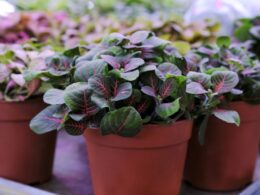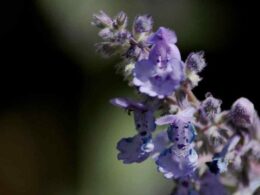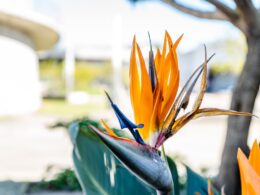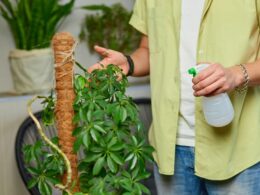What Is a Ti Plant? Species, Origin and Characteristics
Before we get into ti plant care, let’s introduce the species. The ti plant (Cordyline fruticosa or Cordyline terminalis) is a tropical plant that is thought to be native to Southeast Asia, Northern Australia and the regions between them. It’s also known as the:
- Hawaiian ti plant;
- good luck plant;
- palm lily;
- cabbage palm.
This evergreen perennial has stiff, leathery leaves that are dark green or variegated with yellow, pink, or red. The ti plant can grow anywhere from 3 to 13 feet tall, and its leaves can be up to 23 inches long. Its flowers are small and fragrant, and they bloom in the summer.
Ti Plant Care – Soil Type and Fertilization
The ti plant prefers loamy, well-drained soil. If you’re growing it in a pot, make sure that the pot has drainage holes. You can add inorganic matter (such as sand) to your ti plant’s soil to help improve its drainage and aeration.
Fertilizing isn’t too important in ti plant care. You should only fertilize it once or twice a month during the growing season, using a weak solution of liquid fertilizer.
Ti Plant Care – Watering Needs
The ti plant is quite drought-tolerant, so you don’t need to water it very often. It prefers the soil to be consistently moist, but you should allow the top of the soil to dry out slightly between waterings. Use filtered water (or rainwater), or the leaf tips may turn brown.
How Much Light Ti Plants Need
The ti plant can grow in full sun or partial shade. Bright, indirect light is best – too much direct sunlight can damage the leaves. If the ti plant isn’t getting enough light, its leaves will become pale green.
If you’re growing it indoors, place it near a bright window. It’s a good idea to rotate your ti plant periodically, so that all sides of the plant get an equal amount of light.
Ideal Temperatures and Humidity Levels for Ti Plants
Proper ti plant care includes providing the right temperature and humidity levels. This tropical plant prefers warm temperatures (between 65 and 95 degrees Fahrenheit). It can tolerate some cold, but it should be protected from temperatures below 50 degrees. This is why it can only grow outdoors in USDA zones 10 through 12.
The ti plant also prefers high humidity levels. If the air in your home is dry, you can increase the humidity around your ti plant by:
- misting it regularly;
- placing it on a pebble tray;
- using a humidifier.
This way, your ti plant will be getting the humidity it needs without the risk of overwatering. Its leaves will look their best if you keep the air humid.
Pruning Ti Plants
Pruning is an optional part of ti plant care. It helps to encourage new growth and allows you to shape the plant. You can prune your ti plant anytime during the growing season. Just use sharp, clean shears to cut back the stems to the desired length.
How to Propagate Ti Plants
Ti plants are easy to propagate by stem cuttings. To do it, cut a piece of the stem that’s about 5-7 inches long and has several leaves. Remove the bottom leaves, and place the cane in 1 inch of water. Change the water occasionally and pot the plant up once it has rooted.
Repotting Ti Plants
You’ll need to repot your ti plant every two years, once the roots have filled the current pot. To do it, gently remove the ti plant from its pot and shake off any excess soil. Place it in a new, slightly larger pot, and fill the pot with light, loam-based soil. Water well and place the ti plant in a bright location.
Common Problems With Ti Plants
The ti plant is generally a low-maintenance plant, but there are a few problems that you may encounter.
- Brown leaf tips. This is usually caused by too much direct sunlight or dry air. Move your ti plant to a shadier spot, and mist it regularly to increase the humidity around it.
- Yellow leaves. This can be caused by too much water, or by using water that’s high in chlorine. Check the drainage holes in your ti plant’s pot to make sure that it’s not sitting in water.
- Outdoor ti plants can become infested with mealybugs, mites, scales, thrips and fungus gnats. These pests can be controlled with insecticidal soap or neem oil.
If you follow our ti plant care tips, your ti plant will thrive and look its best. It’s unlikely that you’ll encounter any problems, but if you do, now you know how to solve them!
Ti Plant Toxicity to Pets
The ti plant contains sap which is toxic to dogs and cats. Symptoms of ti plant poisoning include vomiting, diarrhea, drooling and lethargy. If your pet has eaten a ti plant, call your veterinarian immediately. In general, keep the plant away from both children and pets, and wash your hands after handling it.
Ti Plant Varieties to Choose From
Now that you know all about ti plant care, it’s time to choose a variety! Each one has its own unique appearance. Here are some of our favorites:
- Cordyline ‘Red Star’ – this ti plant has dark green leaves with red streaks;
- Cordyline ‘Pink Passion’ – this ti plant has hot pink leaves;
- Cordyline fruticosa ‘Sundance’ – this ti plant has yellow and green variegated leaves.
Now that you know how to care for ti plants, why not add one (or two!) to your collection? Let us know which variety is your favorite in the comments below!



















